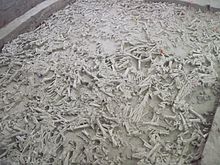Bone bed
A bone bed or bonebed ( English "bone bed" ) accumulation of fossil bone fragments, teeth, scales and coprolites ( "bone breccia "). Since the components of the later bonebed were deposited in the moving shallow water, they are more or less unrolled.
A bonebed can result from the absence of background sedimentation , the subsequent washing out of the fine sediment or from the flooding of the hard parts ( bioclasts ).
A well-known occurrence in the German-speaking area is the Rhät - Lias -Bonebed in the Tübingen area, which is characteristic of the Keuper-Lias transition. On the newly designed geological nature trail on Kirnberg ( Schönbuch ), you can visit a classic find location that was already known in the 19th century.
literature
- Johannes Baier: On the investigation of the Tübingen Rhaetolian border bonebed in the 19th century . Geohistor. Blätter, 23: 85-95, Berlin 2013.
- Johannes Baier: The new geological nature trail in Kirnbachtal (Keuper, Schönbuch). Aufschluss, 71 (2): 81–89, Heidelberg 2020.
- Ulrich Lehmann: Paleontological Dictionary . 4th revised and expanded edition. Enke, Stuttgart 1996, ISBN 3-432-83574-4 .
Individual evidence
- ↑ Johannes Baier: The Tübingen "Rhätolias-Grenzbonebed" . - Fossils 31 (1), 26-30, 2014.
- ↑ Johannes Baier: The geological educational trail on the Kirnberg (Keuper; SW Germany) . - Jber. Middle Upper Rhine. geol. Ver, NF 93, 9-26, 2011.

